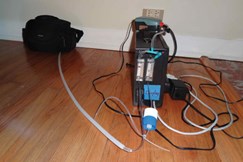A "Smoke And Mirrors" Approach To Remote Explosives Detection
 By James Hargrove, Ph.D., founder, ALTI LLC and David Szpunar, associate professor, Roosevelt University
By James Hargrove, Ph.D., founder, ALTI LLC and David Szpunar, associate professor, Roosevelt University
A new technique based on cavity ring-down spectroscopy can detect NO2 from explosives at sub-ppb levels — and send the results to a smartphone.
Imagine that a U.S. soldier or marine could remotely determine whether a suspect package, garbage pile, or patch of disturbed earth contained a deadly improvised explosive device (IED). And imagine that they would receive the verdict instantly via a go/no-go indication on a standard smartphone. This scenario may soon become a reality, thanks to a project known as FEROS.
The technology behind the FEROS project is the Ferret Optical Sensor, an analyzer that has been laboratory proven to detect sub-ppb (parts per billion) levels of explosives with no known interferences. ALTI LLC uses this patent-pending method to selectively generate nitrogen dioxide (NO2) from explosives. It then uses a sensitive cavity ring-down spectrometer tuned specifically for NO2 with patented gated integrated detection (TD-CARDS-GID) to achieve sensitivity levels limited primarily by the photon noise limit. A scrubber passes the explosive odor while blocking even the most difficult to eliminate interferences such as auto exhaust and cigarette smoke. The technology is being further developed and tested in collaboration with Roosevelt University in Chicago.
Get unlimited access to:
Enter your credentials below to log in. Not yet a member of Photonics Online? Subscribe today.
